► Audi’s flagship SUV gains new Performance trim
► Audi’s most powerful ICE car to date
► Holds Nurburgring SUV lap record
What are the worst-driven cars on the road? An Uber Prius or a new Defender fitted with a god-awful light bar, perhaps? My vote goes to the Audi RSQ8. Usually positioned millimetres from your rear bumper, HD Matrix headlights wedged on full beam and with the Dubai Rolex on the steering wheel glinting even more than the owner’s crystal-white teeth.
Right, I’ll stop stereotyping. As Audi’s tip-top performance SUV, it’s always going to appeal to a certain audience, not least as a junior to the Lamborghini Urus. But Audi pulled off an impressive effort in 2020 with its flashiest SUV to date, utilising some of the best bits from its Volkswagen Group stablemates, not least the Urus.
Given the market for £100,000-plus SUVs is so strong – and the profits are an accountant’s dream – it’s now the turn of the RSQ8 to get a facelift, following on from updates to the Q8 and SQ8 earlier in the year. Importantly, Audi is turning up the fun factor with a new Performance version. Any good?
We’ve driven the Performance in Europe and the regular model in the UK to see if either should be on your spicy SUV wishlist. If you want to know how we reach our verdicts, have a look at our how we test page.
At a glance
Pros: Fabulous V8 engine, monstrous performance, daily usability
Cons: The RSQ8 image, rivals handle better, interior starting to feel old
What’s new?
The mega-performance SUV segment has had quite a shake-up since the RSQ8 first arrived. You can get the definitely-not-an-SUV Ferrari Purosangue, Aston Martin DBX707 and both the Urus and similarly-related Porsche Cayenne have had significant recent updates.
The RSQ8 can’t *quite* compete with that company, but it acknowledges that big numbers sell cars in this segment. Hence a new Performance model follows on from the similarly upgraded RS6 and RS7 Performance. That means more power, reduced sound insulation and questionable new matt carbon detailing that is rather liberally applied. It’s also recently claimed the SUV lap record around the Nurburgring.
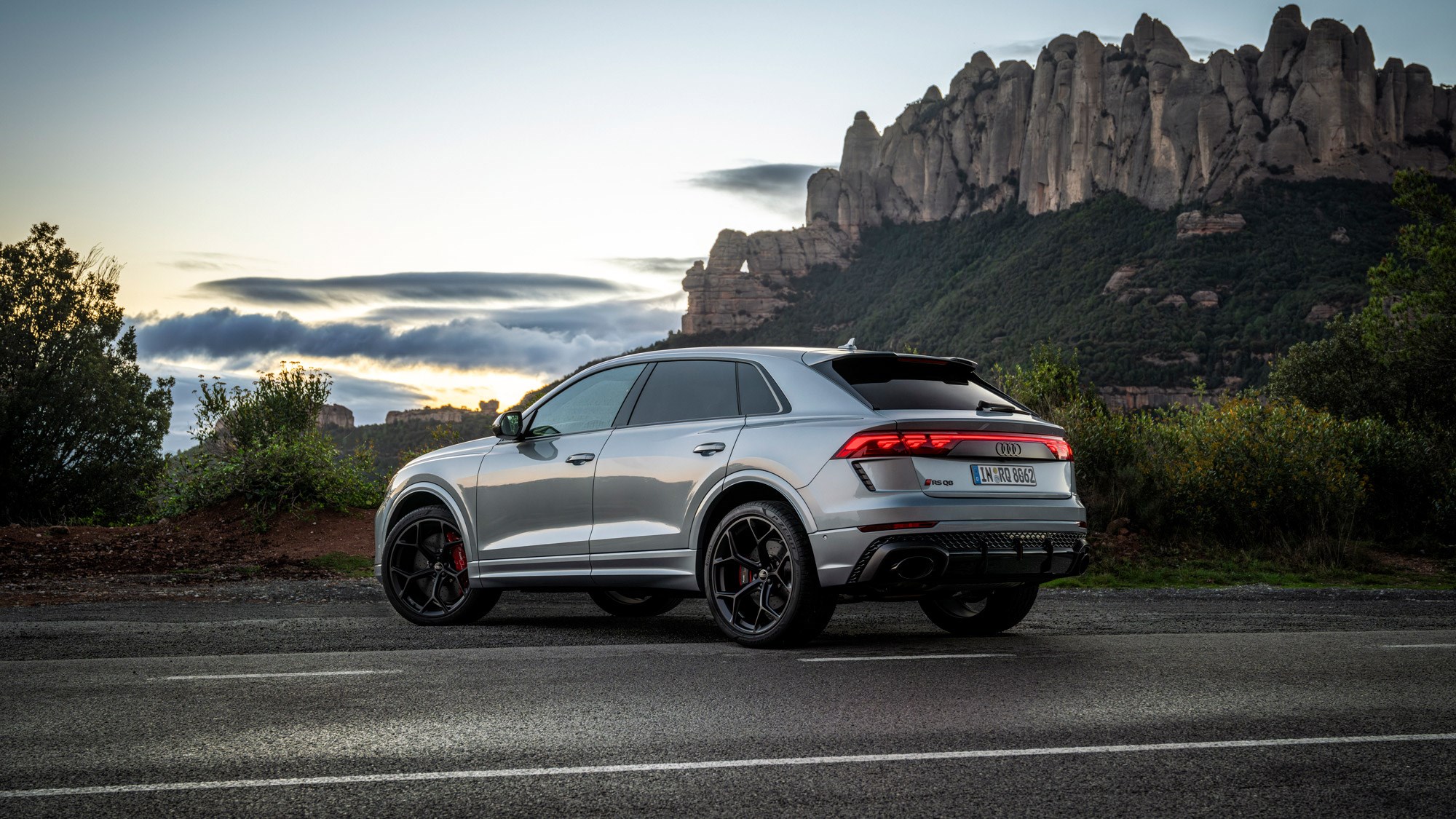
The RSQ8 as a whole gets a facelifted front and rear with fancy new configurable LED lights, and unlike usual Audi RS practice in the UK, the RSQ8 will still be sold in a standard configuration alongside the new Performance trim.
What are the specs?
Audi has resisted electrification pressures and continues selling the RSQ8 with only the mildest of hybrid assistance. That means the same 4.0-litre twin-turbo V8 engine putting out 592hp and 590lb ft of torque in its standard configuration, but the Performance model is the main event. Figures increase to 631hp and 627lb ft of torque, making this the most powerful petrol Audi ever sold – even more so than the new RS6 GT, and matching that of the pre-hybrid Porsche Cayenne Turbo GT.
Sprinting to 62mph takes just 3.6 seconds (two-tenths less than a standard RSQ8) and the usual 155mph top speed is automatically raised to 174mph. An eight-speed Tiptronic is used on both and Quattro is present, obvs.

And get this, the Performance’s lighter sports exhaust and carbon ceramic brakes (both standard) contribute to ‘weight-saving’, well if you can call it that, as the RSQ8 tips the scales at 2,350kg, 40kg lighter than the standard car.
How does it drive?
The engine is the real star of the show in the RSQ8. Unlike a tip-top Cayenne or Urus, there’s no plug-in hybrid nonsense, but just a muscular V8 with an almost violent power delivery. Point it down a straight line and few things could keep up, or prove as raucous. The standard-fit sports exhaust is delightfully anti-social, and with Audi removing sound deadening around the rear and bonnet of the car, both engine and exhaust are much more noticeable now.
In this respect, the Performance model seems a noticeable step up compared to a regular model, itself no sluggard. But the gearbox needs to be in ‘sport’ as it can be pretty lazy in its standard setting. ‘Really, you want to go, sir, you sure?’ and then it finally fires up. Getting your driving modes in order helps this, with the dedicated ‘RS1 and ‘RS2’ settings offering plenty of adjustment to the settings and are well worth the few minutes of time to set up.
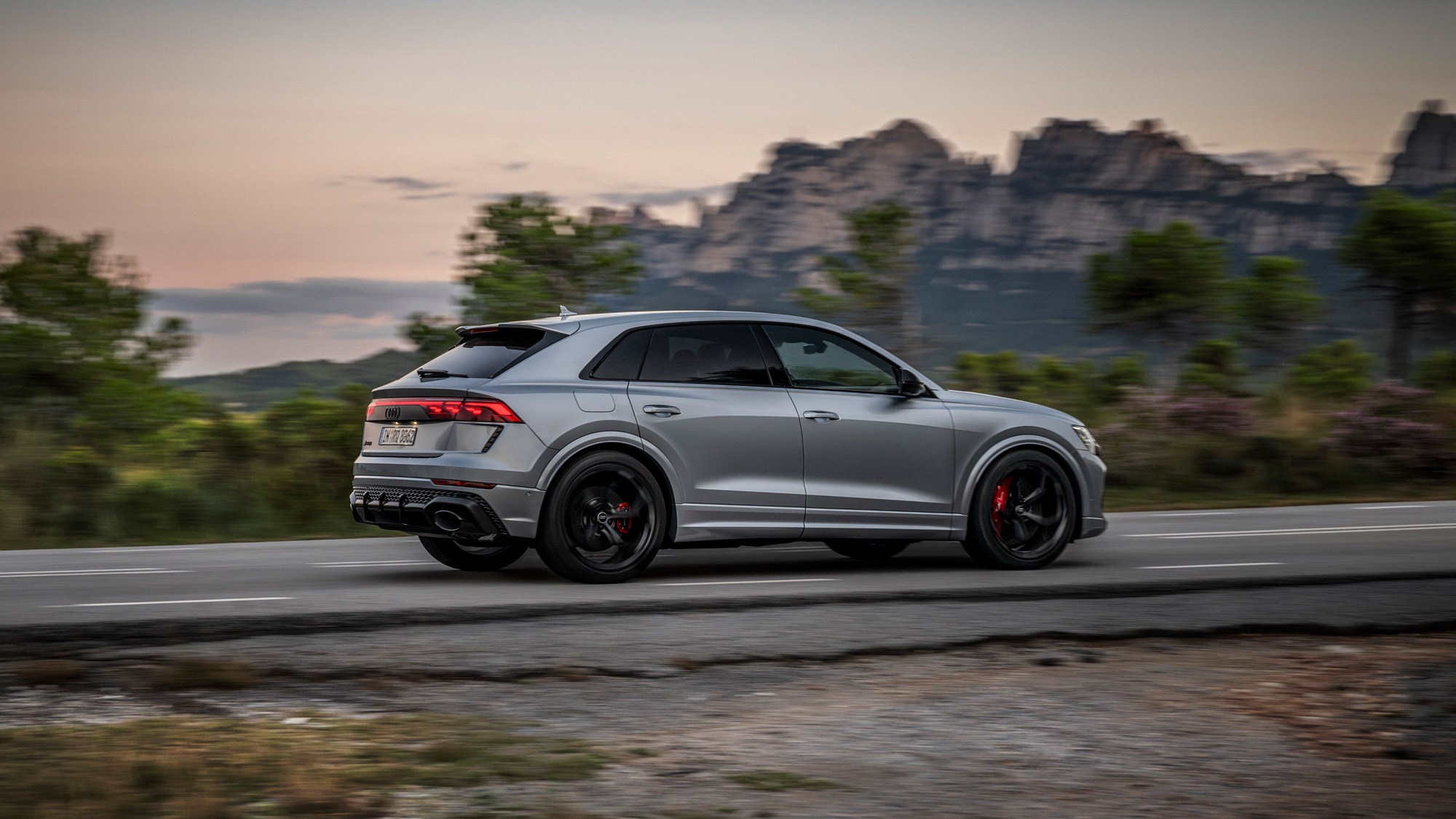
Audi let us loose on the Castelloni race track outside Barcelona, and though admitting few RSQ8s will ever be lapping a circuit, it’s a solid demonstration as to what this SUV can do. It’s a pretty wide track with only one sharper hairpin where even the electronic anti-roll bar and sticky Pirelli tyres (a £425 option) can’t hide its sheer heft. Those ceramics do a remarkable job of slowing the RSQ8 down, but stamp on the pedal and it squirms around a bit. It’s not as sure-footed as a previous Urus Performante on track (though not exactly surprising), but it’s still a pretty remarkable effort for a vehicle of this type, and it stays almost completely flat through a hard corner.
As you’d expect from the VAG hierarchy, the RSQ8 can’t match the Cayenne or Urus’s adjustability or hooliganism. Where those cars use their four-wheel steer and electronics to get the nose tucked in and the tail slightly loose if you’re on it, the RSQ8 remains stable and secure.
The steering is a bit light and lifeless for my liking, though it’s easy to place on a flowing corner. But there’s no hiding the RSQ8’s sheer size, with a London width restrictor easily mullering all four of the 23-inch alloys unless in the hands of a precision driver. Standard-fit four-wheel steering is a big bonus, though, meaning it has a turning circle less than a typical family hatchback.
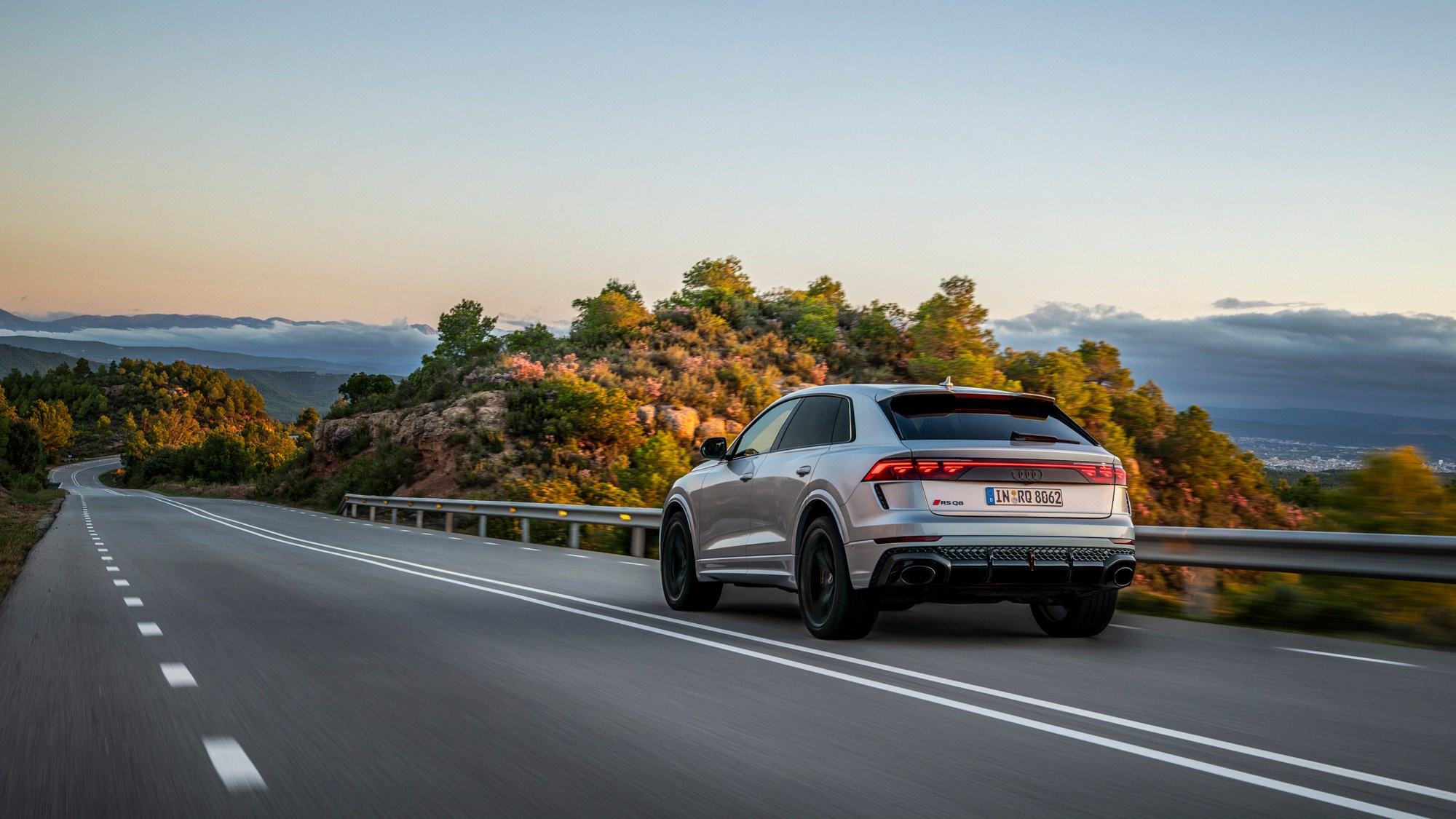
But most impressive about the RSQ8, however, is its usability. Adaptive air suspension is standard and if you put the car in comfort mode it becomes an impressive daily, even when faced with a battered British B-road. Despite the reduced sound deadening, at a steady high-speed cruise, it quietens down brilliantly, with a well-controlled ride even on those frankly ridiculous 23-inch wheels.
In many respects, the RSQ8 feels better resolved and more liveable than the long-term diesel Audi Q8 ran by our sister title Parkers. Even the economy isn’t totally ruinous. Our UK drive saw 22mpg on a road route which isn’t bad given the performance on offer.
What’s the interior like?
One of the few things new about the latest RSQ8’s interior is a new optional ‘RS Design Package’ which brings a cool red, grey or blue pattern on the seats, with matching seatbelts. It’s a nice addition, but only a small distraction from an interior that is really starting to show its age.
The twin touchscreen media system was pretty novel when the Q8 launched in 2018, but now feels a little behind the times. The screens look small and aren’t especially responsive, either. Even all the Alcantara in the world (and there is a lot in this RSQ8) can’t change that. It generally feels a polished and upmarket product, with only some horrid gloss black plastic around the gear selector detracting from this.
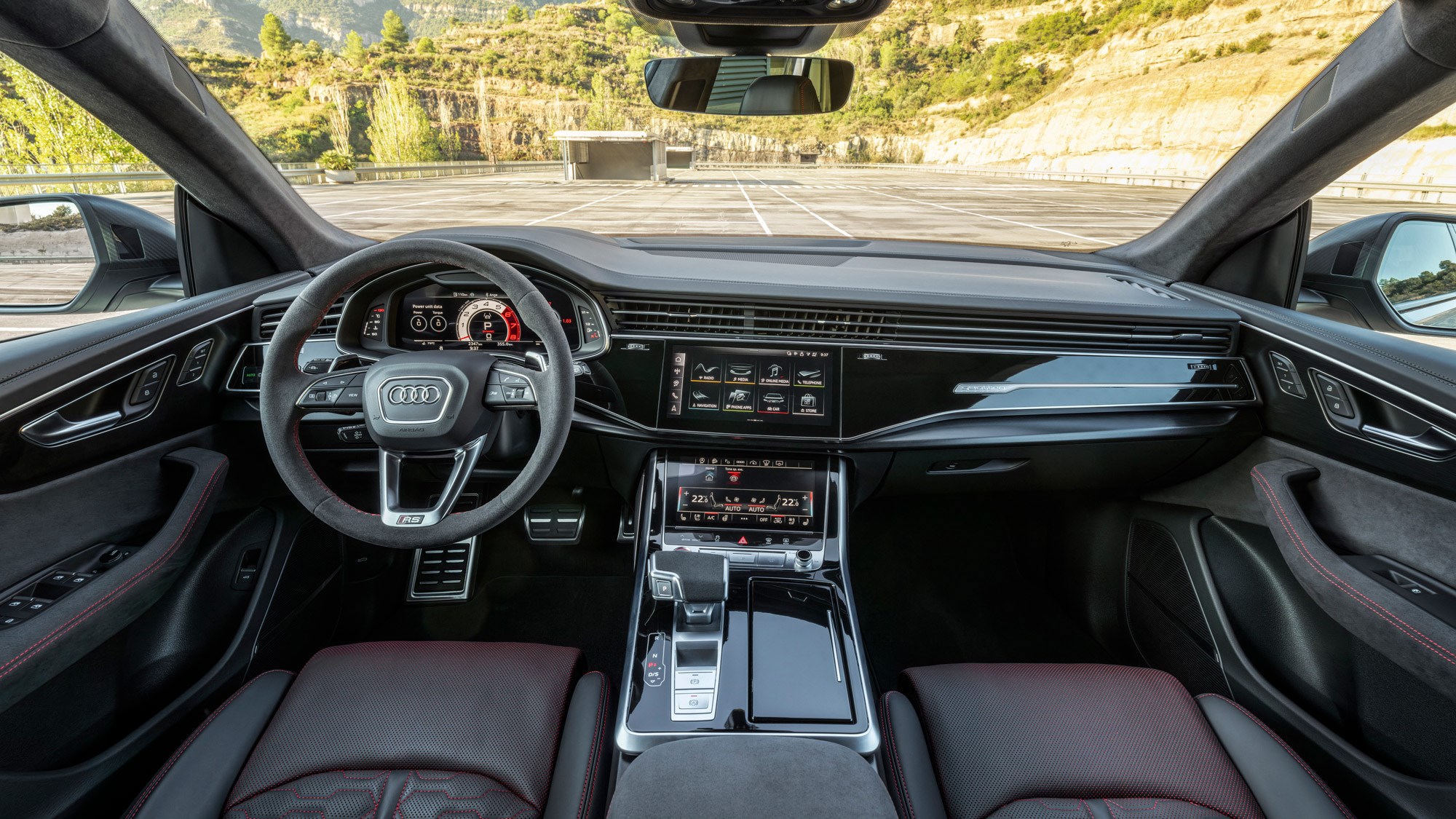
For all its performance, though, the RSQ8 is still a highly usable product that is arguably the most practical and useful of all the super-SUVs. The 605-litre boot is huge, with sliding rear seats and acres of rear-seat space making it an excellent large family car. Prime for school pick-ups in the rich bits of London.
Before you buy (trims and rivals)
Key rivals for the RSQ8 include BMW X5 M Competition and Mercedes GLE 63, but if you want to spend more, the Volkswagen Group’s plusher brands will provide you with a Lamborghini Urus, Bentley Bentayga S or Lamborghini Urus.
Prices for the RSQ8 kick off from £120,550 – £20,000 more than an SQ8 with a slightly detuned version of the same engine. You do get lots to justify the expense, including 22-inch alloys, electric, ventilated and heated leather seats and a 16-speaker Bang & Olufsen sound system. The new Performance model commands significantly more expense at £135,000, and though you’re mainly paying for the extra performance, it brings usually-expensive ceramic brakes and the sports exhaust system.
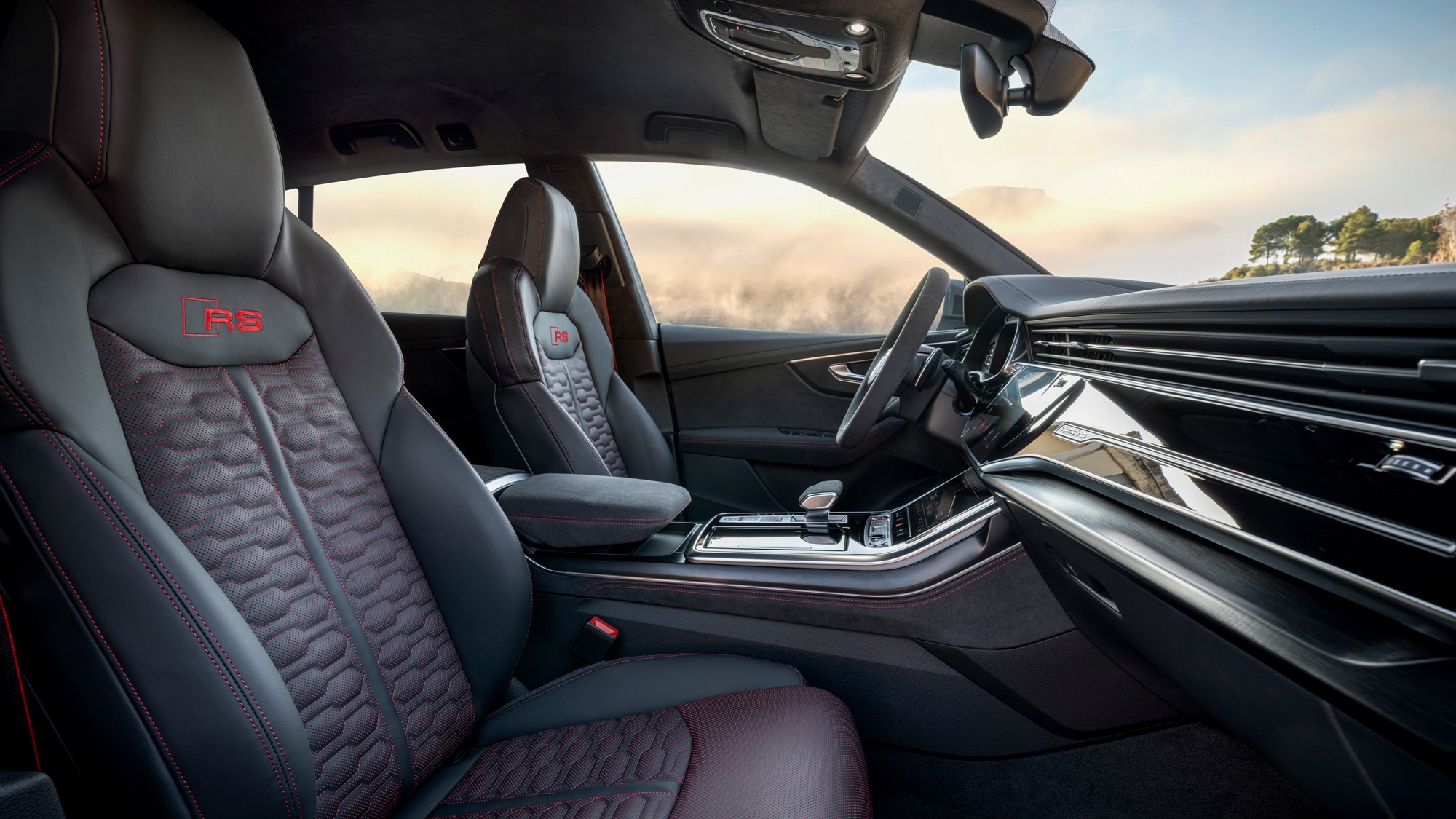
Want it with all the (horrid) matt carbon bits? Well, the Carbon Black will set you £148,000, along with 23-inch alloys. At the top of the line-up, the Vorsprung costs an eye-watering £155,000, though does get a panoramic sunroof, night vision tech and soft-closing doors.
Verdict
The Audi RSQ8 is a true lesson in excess. Its sheer size, its performance, its fuel bills and what it costs to buy are all so OTT. As a petrolhead, it’s the sort of car you want to dislike, but when you get behind the wheel it becomes increasingly difficult to do so.
The V8 engine is nothing short of marvelous, and with its extra pace and more raucous feel as part of the new Performance trim, unlocks a new character that puts it a step closer to the tip-top Porsche Cayenne and Lamborghini Urus – which may have put some off by switching to a plug-in hybrid setup.
Of course, the RS6 is the car you should buy instead, offering all of the performance with far less of a weight penalty. But if you’re set on a super–SUV and don’t want knife-edge handling, you can do far worse than the RSQ8. Just make sure you get on with the interior, as it’s really starting to feel a bit old.